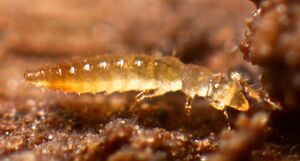Protura

Description
Proturans, commonly nicknamed "coneheads", are a type of hexapod that resides in soil environments. These organisms are very small; either microscopic or barely visible to the naked eye. Proturans, despite having six legs, are not considered to be true insects, though this is controversial. Instead, they are a unique order within the animal kingdom believed to be a sister group to collembola, but may be considered their own separate class. They are collectively comprised of more than 800 species across most continents [1].
Taxonomy
| Domain: | Eukaryota |
|---|---|
| Kingdom: | Animalia |
| Phylum: | Arthropoda |
| Clade: | Pancrustacea |
| Subphylum: | Hexapoda |
| Order: | Protura |
| [3] | |
The determination of a proturan's morphological taxonomy is highly difficult, and only a small number of taxonomists possess the expertise to achieve this. The location and length ratio, particularly of some foretarsal bristles, play a key role in species identification when observing characteristics such as bristle arrangement or pattern. Alternatively, small splices of their DNA can be studied and compared for species identification. While their complete taxonomic rank is still being figured out, we do know that all proturans reside within a suborder of either eosentomoidea or acerentomoidea [2].
Ecology
Proturans have a poor capacity to disperse, which is mostly due to water and human-mediated transmission. They are also soil-obligate, meaning they are restricted to soil habitats and have "mutual" interactions with those environments. However, for up to five days, they can live and move when immersed in freshwater. This fact has helped us discover how proturans have used debris rafts for long-distance traveling, similar to that of other microscopic soil-dwelling arthropods such as mites [4]. Their distribution in aggregates is most likely influenced by their diet, the quality and availability of fungal hyphae, and the creation of aggregation pheromones. Proturans often group together to create species assemblages that represent certain environments. Additionally, they frequently have populations with a high ratio of females to males [5].
Anatomy
There are several main characteristics that may be shared throughout the various species of proturans. These include the presence or absence of a tracheal system, a rostrum, the size and shape of the mouthparts, the number of segments of the abdominal appendages, and the presence or absence of teeth on the lid covering the large glands on the sides of their exoskeleton [7]. Essentially all proturans do not have any antennae or compound eyes. To make up for the loss of the antenna, the growth and usage of abundant and diverse appendages, namely sensilla on their prolegs (fleshy stubs), may be used as sensory parts instead [8].

References
[1] Tipping, C. (2004). "Proturans (Protura)". Encyclopedia of Entomology. Springer, Dordrecht:1842–1843. https://doi.org/10.1007/0-306-48380-7_3467
[2] Resch, M. C., J. Shrubovych, D. Bartel, N. U. Szucsich, G. Timelthaler, Y. Bu, M. Walzl, & G. Pass. (March 2014). "Where taxonomy based on subtle morphological differences is perfectly mirrored by huge genetic distances: DNA barcoding in Protura (hexapoda)". PLoS ONE 9. https://doi.org/10.1371/journal.pone.0090653
[3] Retrieved May 6, 2023, from the Integrated Taxonomic Information System (ITIS) on-line database, www.itis.gov, CC0. https://doi.org/10.5066/F7KH0KBK
[4] Galli, L. & I. Rellini. (July 2020). "The geographic distribution of Protura (Arthropoda: Hexapoda): A Review". Biogeographia – The Journal of Integrative Biogeography 35. https://doi.org/10.21426/B635048595
[5] Galli, L., M. Capurro, E. Colasanto, T. Molyneux, A. Murray, C. Torti, and M. Zinni (January 2020). "A synopsis of the ecology of Protura (Arthropoda: Hexapoda)". Revue suisse de Zoologie 126(2), 155-164. https://doi.org/10.5281/zenodo.3463443
[6] "Festival of Proturans Part II poss. Acerentomon sp." by Andy Murray is licensed under CC BY-SA 2.0
[7] Galli, L., J. Shrubovych, Y. Bu, & M. Zinni. (July 2018). "Genera of the Protura of the world: Diagnosis, distribution, and key". ZooKeys 772:1–45. https://doi.org/10.3897/zookeys.772.24410
[8] Allen, R. T., A. Lawrence, & R. L. Brown. (August 2014). "A comparative study of the sensory structures among three basal hexapodclades (Arthropoda: Collembola, Protura, Diplura) using scanning electronmicrographs". Microscopy and Microanalysis 20:1280–1281. https://doi.org/10.1017/S1431927614008137
[9] "protura_flickr" by Frost Museum is licensed under CC BY-SA 2.0